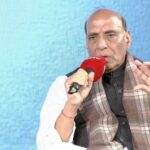MUMBAI: The Reserve Bank of India’s (RBI’s) six-member Monetary Policy Committee (MPC), led by Governor Shaktikanta Das, has decided to maintain the status quo on both policy rate and stance for the seventh consecutive time. This decision is driven by the central bank’s commitment to ensuring last-mile disinflation, with Das indicating that there is no need to start reducing interest rates until inflation reaches the target of 4 per cent.
Highlighting strong momentum in economic activity, Das, in his customary policy statement, said: “Robust growth prospects provide the policy space to remain focused on inflation and ensure its descent to the target of 4.0 per cent.”
Click here to follow our WhatsApp channel
“As the uncertainties in food prices continue to pose challenges, the MPC remains vigilant to the upside risks to inflation that might derail the path of disinflation. Under these circumstances, monetary policy must continue to be actively disinflationary to ensure anchoring of inflation expectations and fuller transmission of the past actions,” he said, explaining the decision to maintain status quo. The repo rate stands at 6.5 per cent.
Recalling 7.8 per cent retail inflation in April 2022, Das said “the elephant in the room” at that time was inflation. “The elephant has now gone out for a walk and appears to be returning to the forest. We would like the elephant to return to the forest and remain there on a durable basis,” he said.
The resolutions on rate and stance were supported by five members, with external member Jayanth Varma voting for a rate cut of 25 basis points and a change in the stance to neutral from the withdrawal of accommodation.
“The strong growth momentum, together with our GDP projections for 2024-25, give us the policy space to unwaveringly focus on price stability,” the RBI governor said. The central bank has retained the 7 per cent growth projection for FY25.
Das also acknowledged the fall in headline and core inflation but pointed out that uncertainties over food prices continue to pose a challenge. “Food price uncertainties continue to weigh on the inflation trajectory going forward,” he said, adding despite the cut in petrol and diesel prices in March, the recent uptick in crude oil prices needs to be closely monitored.
Also, the tight demand-supply situation in pulses and the production of key vegetables warrant close monitoring, given the forecast of above normal temperatures during summer. “Wheat harvesting is by and large over… wheat availability will not be affected as much as it did two years ago, when there were heatwave conditions starting from March. So, in wheat there is not so much concern. But vegetable prices will have to be watched and other impact that heat wave conditions may result in,” Das said.
According to Abheek Barua, chief economist, HDFC Bank, the central bank remains optimistic about growth, pegging it at 7 per cent for FY25 and this provides space for monetary policy to remain tight and focus on inflation. “Consequently, the chances of a rate cut have been pushed forward into the second half of FY25.”
Assuming a normal monsoon, the RBI has projected CPI inflation for 2024-25 at 4.5 per cent, with Q1 at 4.9 per cent, Q2 at 3.8 per cent, Q3 at 4.6 per cent, and Q4 at 4.5 per cent.
Responding to a question on real interest rates — the difference between policy repo rate and one-year ahead inflation projection which is 200 bps, considered high for a developing economy like India – RBI Deputy Governor Michael Patra said one should assess the level of the real rate in terms of the distance at which inflation is from the target.
“Even going 12 months forward, inflation is not at target. So that is our primary objective that we must align inflation with the target,” Patra said.
Das supplemented Patra, saying the primary objective of the monetary policy is price stability. He mentioned that the potential growth rate of India has increased in the past three financial years as the average growth was around 8 per cent. The RBI will conduct a review of potential growth and real interest rates after the FY25 GDP data announcement.
“We will undertake a study after the final GDP numbers for the year 2023-24. It is released end of May. After it is released, we will again undertake a study to assess this potential growth and the real rate. And maybe thereafter we can sort of provide you some additional information,” Das said.
The central bank also expects a boost in private consumption due to improved prospects for Kharif crops because of the expected normal monsoon. “Strengthening of rural demand, improving employment conditions and informal sector activity, moderating inflationary pressures, and sustained momentum in manufacturing and the services sector should boost private consumption,” Das said.
The market, which was expecting somewhat dovish comments on the back of falling inflation, was surprised by the continued hawkish tone. Government bond yields rose by 3 basis points after the MPC meeting outcome. The yield on the benchmark 10-year government bond yield settled at 7.12 per cent on Friday, against 7.09 per cent on Thursday.
Source: Business Standard / The Economic Times
 Rajnath denies bond donations, action against firms linked
Rajnath denies bond donations, action against firms linked 